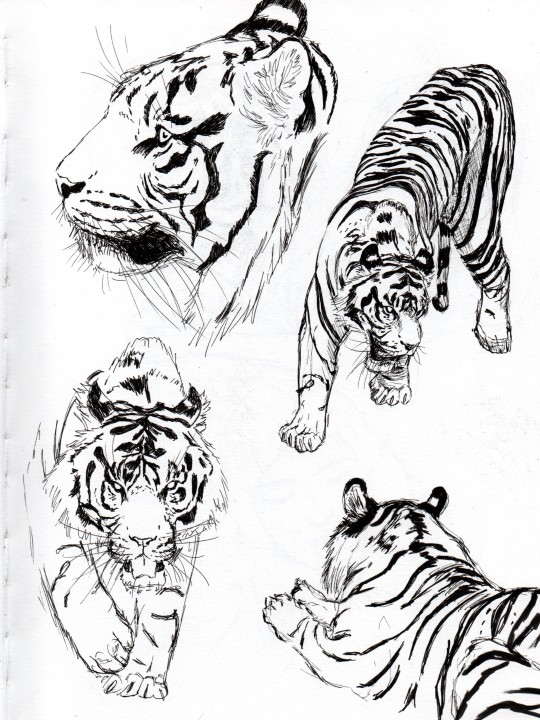Text
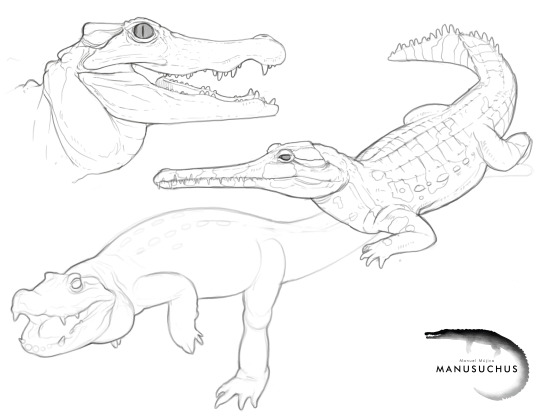
"Crocodiles of the world" lineart sketches #1
#animals#zoology#reptiles#art#nature#wildlife#crocodiles#crocodilians#wildlife art#animal art#artwork#procreate
22 notes
·
View notes
Text

The strange saber-toothed mammal related to marsupials 👀
194 notes
·
View notes
Text
Varanosuchus: First Fossil Croc of 2024
We are two weeks into the year and we already had a bunch of big croc papers, so today I'll cover the first of the two new genera named so far.
Varanosuchus sakonnakhonensis (Monitor lizard crocodile from Sakon Nakhon) is a small atoposaurid neosuchian from the Early Cretaceous of Thailand, a country that has seen a virtual boom in croc papers this past year between the description of Alligator munensis and Antecrocodylus.
Varanosuchus was a small animal, maybe a meter in length if a little longer with a notably short and deep skull and long slender limbs revealing it to have been at least somewhat terrestrial. We actually have a decent amount of material of this guy. The holotype consists of a 3 dimensionally preserved skull as well as assorted postcranial remains (vertebrae, ribs, osteoderms and limbs), there is a second skull of whats likely to be a differently aged individual also showing a 3D skull and well the third ones just a skull table but 2/3 is still great.
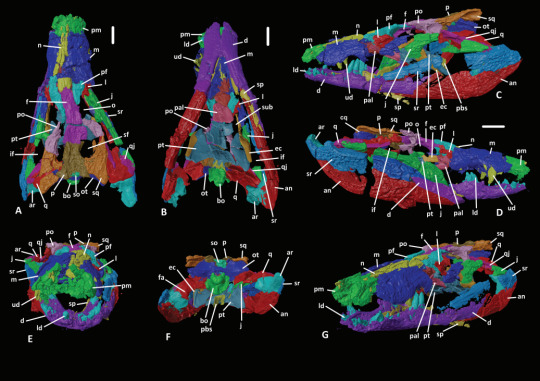

Now this guy was an atoposaurid, which is a group of crocodylomorphs that lived from the Jurassic to the end of the Cretaceous, their last members existing on the island of Hateg some 66 million years ago. Atopsaurids were generally small animals with short snouts and longish legs. Some examples of atoposaurids include Knoetschkesuchus from Germany, Aprosuchus from Romania and Alligatorellus from France and Germany, all three pictured below, art by @knuppitalism-with-ue
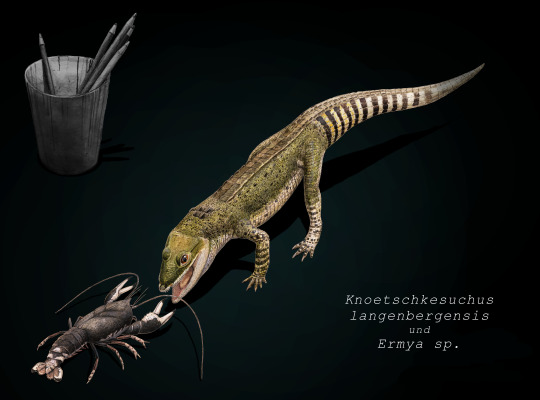
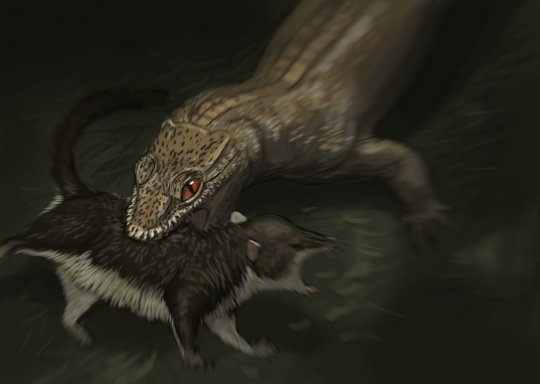
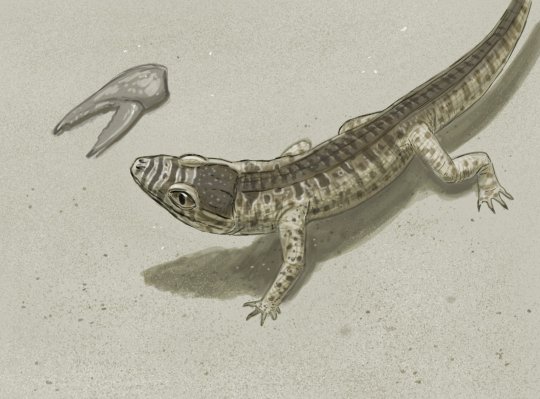
Now the matter of ecology for atoposaurids in general and Varanosuchus in particular is not clear. Altirostral skulls such as that of Varanosuchus are generally associated with terrestrial crocodylomorphs as best examplified by notosuchians. Their teeth and size both obviously speak against being shoreline ambush predators like modern crocs and their legs are straight and slender, suggesting they had an erect posture and not the more sprawling one seen in semi-aquatic forms. Though they could have still had some aquatic affinities. The authors for instance argue that the osteoderms, having plenty of pits, are more like those of an animal that spends time in the water and would thus use them in thermoregulation. So maybe they did enter water from time to time, somewhat like some modern lizards, tho I think its fairly certain that they spend a decent amount of time on land. The artwork below is the reconstruction from the paper itself.
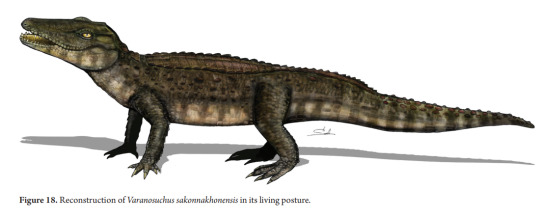
Another matter discussed in the paper is phylogeny, more precisely the relationship of Neosuchians and how Eusuchia is defined. On the first front, its worth noting that the paper recovered both atoposaurids and paralligatorids as monophyletic groups and had them be each others closest relatives, a notion that has been recovered before. More interesting perhaps is the fact that the next closest relatives to these two were hylaeochampsids and Bernissartia, which are typically recovered closer to modern crocs. Which in fact form a separate branch that is the sister group to all the afforementioned clades and taxa. And then you got goniopholids, dyrosaurs and pholidosaurs which are all more basal than the paralligatorid+atoposaurid+crocodilian group, which is back to the ordinary really. The second thing is the definition of Eusuchia. So for the longest time Eusuchia has been defined to include those Neosuchians that have choanae that are fully enclosed by the pterygoid bones (I know I know a bunch of anatomy stuff bear with me). So if the choanae was surrounded by the pterygoid, its an Eusuchian, if not, its more basal. Well, atoposaurids don't have that....BUT VARANOSUCHUS DOES. This, coupled with hylaeochampsids also having this feature and being recovered closer to atoposaurids than to Crocodilians basically suggests that the feature is not diagnostic for Eusuchia and instead appeared multiple times independently.
Moving away from anatomy and phylogeny and all that stuff, I think its very cool that croc research in Thailand has kinda picked up this last year. And fittingly enough some people have even worked on a short documentary covering the known diversity of pseudosuchians from Thailand, giving an overview over the named forms from the Jurassic to today, from titans like Chalawan to even these newest dwarf forms. While the narration is obviously in Thai, there are English subs and I highly recommend looking into it (even if I disagree with their depiction of Varanosuchus as arboreal, its perhaps overshooting the goal a little bit).
youtube
Finally here's the paper itself (tho paywalled)
New Cretaceous neosuchians (Crocodylomorpha) from Thailand bridge the evolutionary history of atoposaurids and paralligatorids | Zoological Journal of the Linnean Society | Oxford Academic (oup.com)
and the wikipedia page I've been working on
Varanosuchus - Wikipedia
I'll try to write up a post on the other new genus, Garzapelta, later this weekend so stay tuned for that.
192 notes
·
View notes
Text
Pseudosuchians described in 2024 #1 Varanosuchus sakonnakhonensis

First of a series of quick sketches that I´ll try to do for each pseudosuchian that will be published throughout 2024 (I don't promise that I'll do all of them).
I will give priority to everything that is closer to the crown group of the current crocodilians, although if I get too motivated I might even include phytosaurs, although I doubt it extremely.
And yes, Im informed about Garzapelta, and I take this opportunity to say that I am sorry to all the aetosaurs´s fans, but these are totally excluded from the series because they are, objectively speaking, not only the most tedious tetrapod group to draw, but also the most boring looking (The truth hurts, I know).
Now I could give a description of what Varanosuchus is and all that, but as usual, Armin has done it faster and better, so go and read his instead
31 notes
·
View notes
Text
Fossil Crocs of 2023
2023 has been a year with its ups and downs, but one consistent thing has been its fossil crocs at least, giving us another interesting variety of species and genera not known before. Like last year, I'll go down each of them (including phytosaurs) and give you some key notes. And since I've done my best to make individual posts for them I'll link those when available. I'll also try to give translations where possible, but do note that sometimes I might switch around a word due to it just sounding awkward otherwise.
Scolotosuchus
Starting us off is Scolotosuchus basileus ("royal scythian crocodile"), a basal, rauisuchian-like animal from the early stages of the Triassic. An animal roughly 3 meters long, it is primarily known from vertebrae and some other material, which however does have interesting implications. Based on the anatomy of the vertebrae, it has been speculated that Scolotosuchus performed a lot of rapid movement of the neck, presumably while hunting. Furthermore, it might be that Scolotosuchus lacked osteoderms, instead having developed a bracing system for its body much more like that of dinosaurs and mammals.
Artwork by @knuppitalism-with-ue (he'll pop up quite a lot)

Colossosuchus
Fast forward to the Late Triassic, the hayday of early Pseudosuchians, and we find our first phytosaur of the list. Colossosuchus techniensis ("colossal crocodile of the Indian Institute of Technology") was an enormous animal from India's Tiki Formation. This one is known from undisputably better material, perhaps some of the best on this list as we have an entire bone bed of these guys, possibly representing a mass death site. Size estimates of the large specimens generally range from 6 to 9 meters in length, also making it the largest animal of this list, with the authors favoring an estimated 8 meters for the largest individual. Of course this is all subject to change, as we don't know the precise proportions (the downside of a bone bed is that all the bones are kinda jumbled together and god knows what belongs to what).
Artwork by Joschua Knüppe again, a female being courted by an overconfident and confused Volcanosuchus (told you so)

Kryphioparma
Ok I won't bother you with this one too much. Kryphioparma caerula ("blue mysterious shield") is an aetosaur from the Late Triassic Chinle Formation of Arizona. Now aetosaurs are cool of course, but the thing is that Kryphioparma is known from exclusively osteoderms, their large armour plates. While thats valid, its also not really exciting (as you could have guessed from the absolute lack of artwork). Best I can say is that it coexisted with a bunch of other aetosaurs, which surely would have been a sight to see back in the day.
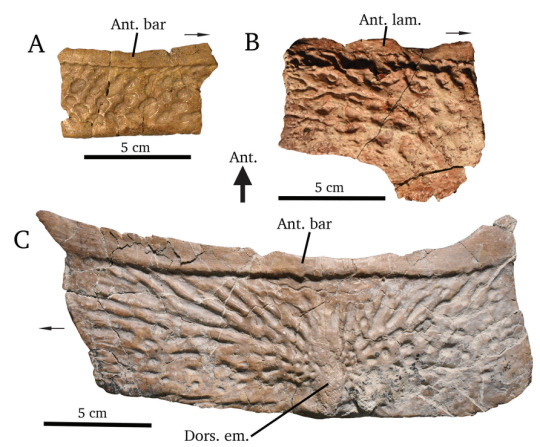
Venkatasuchus
Now Venkatasuchus armatum ("Venkata's armoured crocodile") is in a similar boat. This Indian aetosaur too is only known from osteoderms, tho at least a lot more of them that were found together, meaning we got a much better idea of its shape. There are some interesting implications it has on paleogeography and how different animal groups spread across Pangea, but that's probably beyond the scope of this post. There is at least some art of it tho, including one piece by Joschua featuring Jaklapallisaurus, an early sauropodomorph.

Mystriosuchus alleroq
Now we got our first new species of a preexisting genus. While I did my best to make posts on new genera, which typically went hand in hand with their respective wikipedia pages, species are a different matter since they'd require me to overhaul and research the whole genus. Which for Mystriosuchus would go all the way back to 1896.
Anyhow, Mystriosuchus alleroq ("jawbone spoon crocodile") is the newest in a long line of Mystriosuchus species and has been recovered from western Greenland of all places. Like Colossosuchus it is known from multiple individuals, at least four in fact, And like Venkatasuchus, it appears to have wideraning implications for the spread of archosaurs during the Triassic. Oh look its Josch's art again, neat.

Jupijkam
The final phytosaur and the final Triassic taxon of the year, Jupijkam paleofluvialis ("horned serpent of ancient rivers") was recovered from Nova Scotia Canada and represents one of the northernmost phytosaurs (alongside obviously our friend Mystriosuchus alleroq above). It is far less complete than the other phytosaurs I covered so far, but still nothing to scoff at. It's also one of the youngest known phytosaurs, possibly having lived during the last stage of the Triassic. There's no art but here's an image of its snout from the original paper.
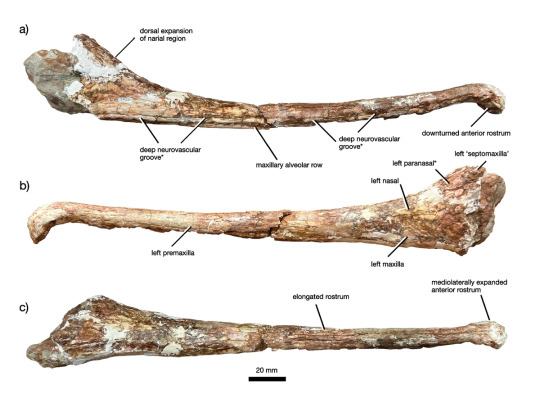
Turnersuchus
And with this we have reached the Jurassic and somewhat of a double feature. Ordering these via chronology makes this almost like storytelling. Turnersuchus hingleyae ("Hingley's and Turner's crocodile") is the oldest and basalmost named thalattosuchian, a group of crocodylomorphs that took to the seas. As such it shows a mosaic of features, already having begun to reduce its limbs, having a moderately long snout and still bearing osteoderms, which some of its descendents would come to lose. Turnersuchus dates to the Pliensbachian, a stage of the early Jurassic, tho the paper mentions how its not likely to hold its title as oldest member of its group for long as even older material has been discovered and is awaiting publication.
Artwork by Júlia d’Oliveira and Joschua Knüppe
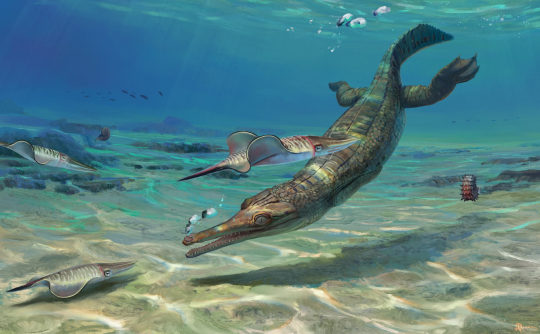
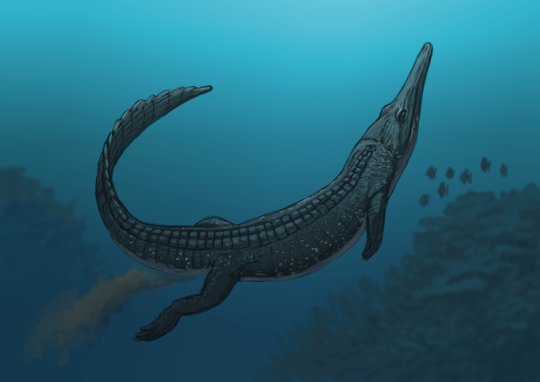
Torvoneustes jurensis
While Turnersuchus gives us a glimpse at what the earliest thalattosuchians were like, Torvoneustes jurensis ("savage swimmer of the Jura Mountains") represents them at one of their most derived. At 4 meters long, it must have been an impressive creature, entirely smooth and lacking osteoderms, highly reduced arms and a tail fluke to boot. There are some interesting features, as unlike other species of Torvoneustes, this one does not appear to have been as durophagous, instead appearing to be more of a generalist. It's the last Jurassic croc of the year and practically lived at the opposite end of this time period relative to our previous thalattosuchian, during the Kimmeridgian. Artwork by Sophie De Sousa Oliveira, not to be confused with Jùlia who drew Turnersuchus.

Comahuesuchus bonapartei
From marine to terrestrial, Comahuesuchus bonapartei is a member of the Notosuchia, land-dwelling cousins to the Neosuchia. This new species is known from the Cretaceous of Argentina and was described on the basis of a lower jaw, which differs from the previously described species of Comahuesuchus by the fact that the teeth are situated in individual sockets. Its jaws were short and wide, being described as U-shaped, giving it a somewhat pug-nosed appearance. In case you're wondering why I don't have the translation of the name thats because I can't access Bonaparte's first paper, so all I can say is that the new species is named after famed Argentinian paleontologist Jóse Fernando Bonaparte. Artwork by I mean you probably guessed it, its Josch again.
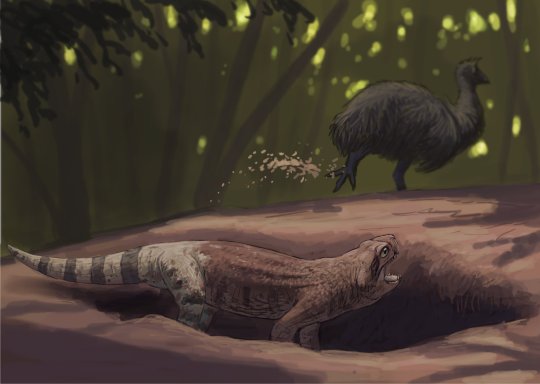
Aphaurosuchus kaiju
I have some mixed feelings on Aphaurosuchus kaiju ("powerless kaiju crocodile"), not just because I have to rewrite its genus wikipedia page that I am no longer happy with. No, Aphaurosuchus is a great genus in my opinion, given the complete nature of the holotype. But I do think that the species name of this second form is a bit of an exaggeration, seeing as it is to my knowledge not that exceptionally big. So why name it kaiju other than to sound cool? I also think it just kinda becoms funny when you consider the meaning of the genus name. Anyhow, it does look pretty mean, but thats to be expected from a baurusuchid. It lived during the Late Cretaceous in Brazil and the phylogenetic analysis that accompanied its description had some interesting implications that I'm curious to see tackled in the future. Other than that it's just another baurusuchid from a place crawling with baurusuchids, which tbh is pretty cool itself but doesn't really help make it stand out. Arwork by Paula Zeinner
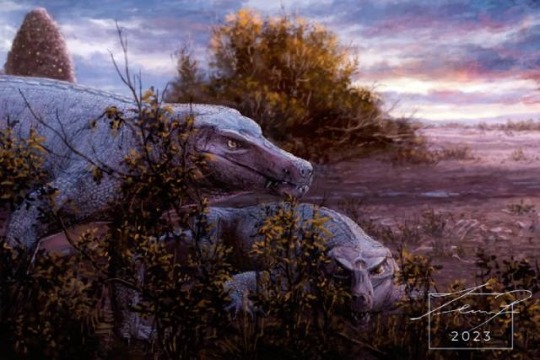
Dentaneosuchus
It is the middle Eocene. France is entirely occupied by mammals. Well, not entirely... One indomitable reptile still holds out against the invaders. Yes, I am of course talking about Dentaneosuchus ("frightfull crocodile"), the titan of the Eocene, the terror of the jungle. Easily among the most exciting finds, this animal was an enormous sebecid previously thought to be a member of the genus Iberosuchus, but recent research not only shows its distinct but enormous. With a lower jaw around 90 cm long, it rivals even the famed Barinasuchus of Miocene South America. The total body lenght is of course a matter of debate given how little we know about sebecid proportions, with the paper lowballing it at 3 to 4 meters and I personally recovering something more akin to 5 meters. Regardless of the specifics, this would make it easily one of the top predators of its time, tho sadly this was not meant to last. It was among the last non-mammalian apex predators of Europe, before climate change and competition from mammals eventually drove them to extinction.
Arwork by Joschua Knüppe and @mariolanzas
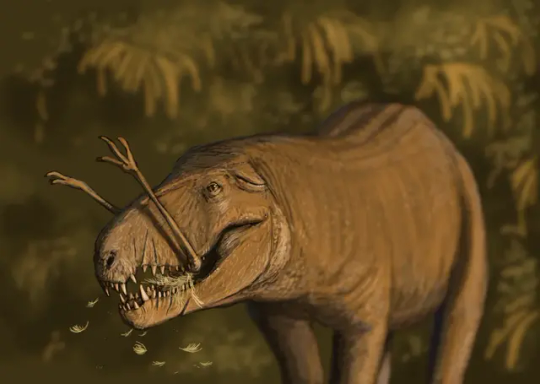
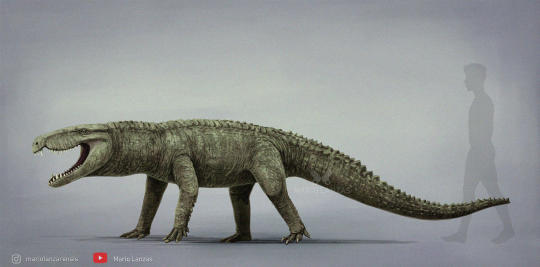
Baru iylwenpeny
Our last three entries were all members of the Notosuchia, the terrestrial crocodiles that existed from the Jurassic to the Miocene, so lets jump to the other major group of the time, the Neosuchians, specifically their most recent branch, the Crocodilians. Yes finally we are getting to crocs in the stricter sense.
Baru iylwenpeny ("divine crocodile thats good at hunting") is an animal we also knew for a while under the informal name Alcoota Baru based on where it was found. This year I spent a lot of time writing in the Mekosuchinae, Australasian crocodiles of the Cenozoic and just when I had finished the page for Baru, this guy got published. It's the largest, most robust and most recent member of the genus. Good at hunting is a good choice for the species name, as this animal was over 4 meters long with a head commonly likened to a cleaver and a hunting style speculated to consist of inflicting a lot of trauma on its prey with its massive teeth. I could gush about Baru for ages, but thats the important parts. It lived in central Australia during the Miocene only 8 million years ago.
Artwork by the incredible @manusuchus
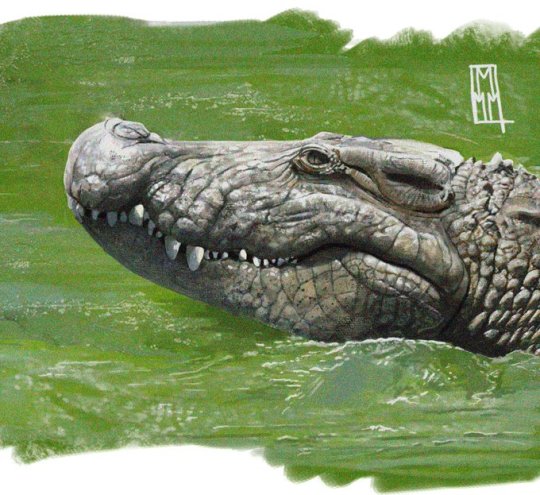
Antecrocodylus
Now for the last crocodilian described this year and one I remised to make a dedicated post for due to time constraints (I had a busy few months). Antecrocodylus chiangmuanensis ("before Crocodylus from Chiang Muan") is a close relative of the modern dwarf and true crocodiles from the Miocene of Thailand. It is only known from the back of the skull and an associated lower jaw, but it serves to highlight how little we know about the crocodiless of eastern Asia during the Miocene, which is a shame given that this region is crucial to deciphering where true crocodiles originated.

Alligator munensis
And our final taxon is Alligator munensis ("Mun river alligator"), which, obviously, is a member of the modern genus Alligator and thus most closely related to the still extant Chinese and American Alligator. Likely having been split from its Chinese relatives when the Tibetan plateau was lifted up, this species lived during the middle Pleistocene in Thailand and may have survived until the Holocene. It's head was short and robust and its teeth globular, which could indicate that it fed on hard-shelled prey like clams and snails. It was also small, likely not much bigger than 1.5 meters.
Artwork by Joschua Knüppe
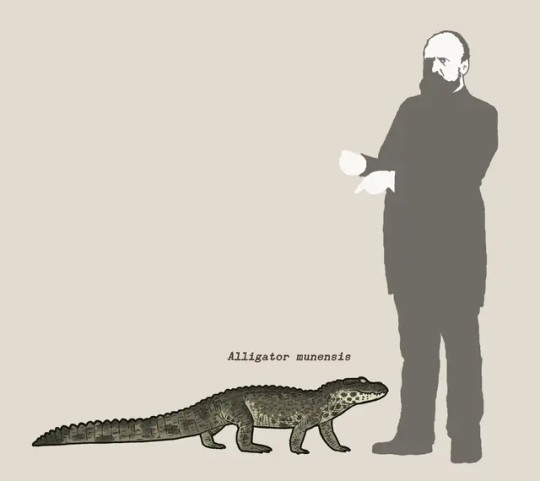

And that should be all of them, all new species and genera of Pseudosuchians described this past year. It's once again been fun to look back and I hope that you find them just as interesting as I do. Lets hope that 2024 will bring equally fascinating discoveries.
260 notes
·
View notes
Text

Dinictis felina
A Nimravidae genus from Late Eocene/Early Miocene North America.
Dinictis did not reach large sizes (1.1 m long and 0.6 m high), probably occupying an ecological niche similar to that of some of today's small/medium-sized wild cats, since the position of top predators was occupied by creodonts such as Hyaenodon or entelodonts like Archaeotherium.
I must remind you that, although superficially very similar, nimravids like Dinictis were not closely related to true felids, just being another extreme case of convergent evolution.
#animals#zoology#art#nature#paleoart#wildlife#paleontology#sabertooth#nimravids#dinictis#cats#cats of tumblr#big cats#digital art#digital illustration#digital drawing#evolution#earth#north america#hunter
104 notes
·
View notes
Text

My gift for @mathpope from a recent discord “secret Santa” art exchange! I give you the great California Condor, king of North American vultures, lording over a megafaunal feast.
Some notes on the border art: the tree branch flourishes up top depict bristlecone trees, another unique Pleistocene holdover that clings to existence in remote parts of California. The insects in the curve of the mammoth tusks are condor lice (Colpocephalum californici), a parasite that fed exclusively on California condors and went extinct when the 22 birds left in existence were captured and de-loused for the breeding program to save their species. The woven art on the sides depicts two indigenous myths about condors, left side as a beneficial entity, saving humanity from a primordial flood (Wiyot), and right side as a bloodthirsty antagonist that gets beheaded by Ground Squirrel (Mono). The bones overhead (mammoth, moose, horse) are all Pleistocene megafauna that the condor would have been specialized in feeding on.
Thanks for another fun trade!
735 notes
·
View notes
Text
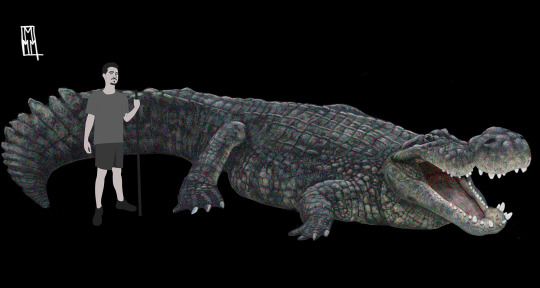
Deinosuchus : The monstrous Alligatoroidea that ate tyrannosaurs
Much has been said about the well-known Deinosuchus, the genus of giant Alligatoroidea from the Cretaceous of North America. Three different species of Deinosuchus are currently known: D. hatcheri, the recently described D. schwimmeri and D. riograndensis (Whose main defining characteristic are two enigmatic fenestrae on the premaxilla whose functional morphology remains uncertain. I will discuss this topic in depth in a specific post later, once I have finished the illustrations for it). On average, the specimens of D. riograndensis are much larger than those of D. schwimmeri (In the case of the holotype of D. hatcheri CM 963 , this is close to/equal to the size of the largest specimens of D. riograndensis) , its possible that this is due to the fact that D. riograndensis in particular was subject to more favorable environmental conditions (For example, a greater number of prey) that allowed them to reach larger sizes. This illustration try to represent the maximum size of D. riograndensis based on the estimates proposed for specimen TMM 4362-1, about 12 m TL and 8,000 kg. Myself (1.75 m) as reference.
#animals#zoology#reptiles#art#nature#paleoart#crocodiles#wildlife#crocodilians#paleontology#deinosuchus
107 notes
·
View notes
Text

Little warmup of Tree Kangaroos after some weeks without drawing anything on digital
124 notes
·
View notes
Text

Zygomaturus sp.
A large Diprotodontidae from the late Miocene-Pleistocene from Australia.
Marsupials are really the coolest thing on this earth.
#animals#zoology#art#nature#paleoart#wildlife#paleontology#australia#marsupial#mammals#wildlife art#digital art#digital illustration#sketch#sketchbook
97 notes
·
View notes
Text

Baru iylwenpeny
The recently described new species of the genus Baru, with a particularly robust and beautifully preserved skull.
#animals#reptiles#zoology#art#nature#paleoart#crocodiles#wildlife#crocodilians#sketch#sketchbook#animal art#paleontology#australia#digital illustration
222 notes
·
View notes
Text
A very common behavioral characteristic in all modern felines.
Although they generally do it to better observe what is out of reach, they may also do it in case they feel threatened by imminent danger in order to appear larger.
This is not just healthy speculation, but a behavior more than likely in all members of Felidae.


Smilodon
Smilodon fatalis sitting down to look what r u doing over there

461 notes
·
View notes
Text
Ahh you are totally right. The worst of it all is that I read the news when it came out but my mind had completely omitted it. I guess it's hard to correct years of internalized misinformation.

Tasmania , just a blink of an eye ago
September 7th, 1936. The last captive thylacine, a male nicknamed "Benjamin", died from unknown reasons at the Hobart´s Beaumaris Zoo.
Two months later, thylacines became a legally protected species.
In 1982, park ranger Hans Naarding was surveying in north-west Tasmania when he stood for several minutes with his torchlight fixed on a thylacine. It is the last credible sighting of the animal in the wild.
That same year, the IUCN declared the Thylacine, commonly known as the "Tasmanian tiger", officially extinct.
Photos, videos and sightings have been regular since then, none really worthy of consideration as late evidence of the species' late survival.
Companies of questionable morality have promised to bring the species back from extinction through cloning and genetic engineering.
But the thylacine is gone forever. That's the hard truth.
We can try to convince ourselves that somewhere, hidden and far away from humans, they are still alive. We can try to convince ourselves that our advanced technology will reverse the mistakes of the past and change the natural order.
But the thylacine is gone, and that will not change.
This sad story leaves us with an important lesson: We must put all our efforts and resources into conserving the species that remain in our world.
May the Thylacine always remain an eternal reminder of what extinction means.
282 notes
·
View notes


